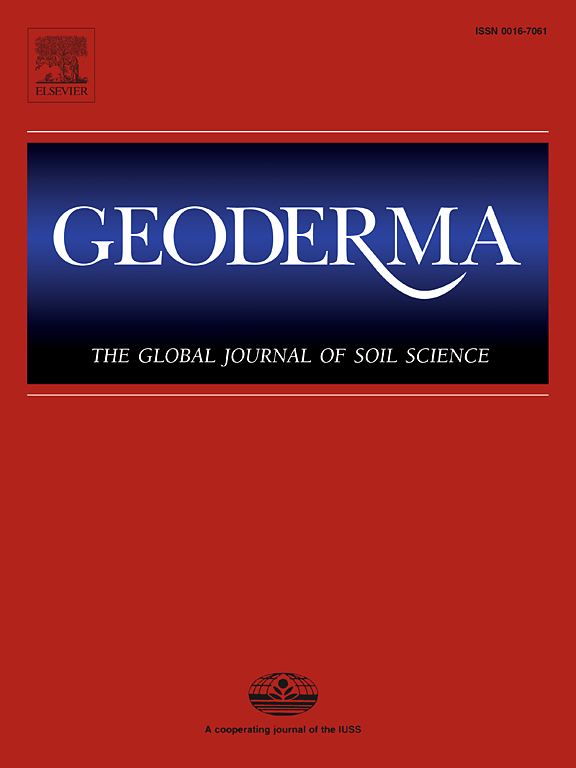Sources and fate of CO2 along the soil–aquifer–stream–atmosphere continuum (the Orgeval headwater catchment, France)
IF 5.6
1区 农林科学
Q1 SOIL SCIENCE
引用次数: 0
Abstract
Few studies have examined CO2 sources and pathways along the soil–aquifer–stream–atmosphere continuum. We measured the water concentration of dissolved CO2, HCO3–, and dissolved organic carbon (DOC), together with ancillary variables (pH, total alkalinity [TA], and major ions [Ca2+, Mg2+, SO42-, NO3–]), in piezometer transects and adjacent streams at a monthly interval over a 5-year period (2019–2023). Such a continuum was studied within a small catchment underlain by carbonate geology and subject to intensive agriculture.
On the basis of the values of Ca2+, Mg2+, SO42-, and alkalinity in the upslope and downslope piezometers, we assumed that the more mineralized downslope water would characterize the slow groundwater flow component of the stream, while the less mineralized upslope water would reflect a fast sub-surface flow (surface runoff + agricultural drainage flow). These water flows components were calculated using the HYPE calibrated hydrological model.
Accounting for weathering reactions and using a mass balance of dissolved C fluxes, we found that the total alkalinity flux (as HCO3–) reaching the river (amounting to 29 Mmol yr−1, i.e., 79 kgC ha−1 yr−1) derived for about one third from soil CO2 respiration, one third from carbonate dissolution induced by the reaction with CO2, and one third from carbonate dissolution induced by the acidity generated by nitrification of reduced N fertilizers.
The groundwater CO2 fluxes to the stream (13 Mmol y-1, i.e., 36 kgC ha−1 yr−1) were 2 orders of magnitude lower than the total direct soil CO2 flux emitted to the atmosphere. Most (at least 95 %).of the groundwater CO2 fluxes was degassed once reaching the stream.
Dissolved organic carbon flux to the stream represented only ∼ 2 % of the total dissolved carbon flux to the stream; the input of dissolved CO2 in rainfall to the soil–aquifer system amounted to less than 1 % of this total dissolved carbon flux to the stream.
The carbonate weathering induced by soil respired CO2 amounted to ∼ 26 kgC ha−1 yr−1 in the Avenelles sub-catchment, representing ∼ 0.5 ‰ yr−1 of the total soil organic carbon stock. The alkalinity flux generated by this process might hence act as significant soil transient CO2 sink, depending on the prevalence of downstream processes affecting the stream carbonate buffering and speciation.

沿土壤-含水层-河流-大气连续体的二氧化碳来源和去向(法国奥格瓦尔水源集水区)
很少有研究考察沿土壤-含水层-河流-大气连续体的二氧化碳来源和途径。在2019-2023年的5年时间里,我们以每月为间隔测量了测压仪样带和邻近溪流中溶解CO2、HCO3 -和溶解有机碳(DOC)的水浓度,以及辅助变量(pH、总碱度[TA]和主要离子[Ca2+、Mg2+、SO42-、NO3 -])。这种连续体是在一个受碳酸盐地质影响并受集约化农业影响的小集水区进行研究的。根据上坡和下坡测压计的Ca2+、Mg2+、SO42-和碱度值,我们认为矿化度越高的下坡水表征了河流中缓慢的地下水流动成分,而矿化度越低的上坡水则反映了快速的地下水流(地表径流+农业排水流)。这些水流分量是使用HYPE校准的水文模型计算的。考虑到风化反应并利用溶解C通量的质量平衡,我们发现到达河流的总碱度通量(如HCO3 -)(达29 Mmol yr−1,即79 kgC ha−1 yr−1)约有三分之一来自土壤CO2呼吸,三分之一来自与CO2反应引起的碳酸盐溶解,三分之一来自还原性氮肥硝化产生的酸性引起的碳酸盐溶解。地下水流入河流的CO2通量(13 Mmol y-1,即36 kgC ha -1 yr -1)比直接排放到大气中的土壤CO2通量低2个数量级。大多数(至少95%)。地下水的CO2通量一旦到达河流就被脱气。流入河流的溶解有机碳通量仅占流入河流的总溶解碳通量的约2%;降雨中溶解的CO2输入到土壤-含水层系统的量不到河流总溶解碳通量的1%。在Avenelles子集水区,土壤呼吸CO2引起的碳酸盐风化为~ 26 kgC ha - 1 yr - 1,占土壤有机碳储量的~ 0.5‰yr - 1。因此,这一过程产生的碱度通量可能作为重要的土壤瞬态CO2汇,这取决于影响溪流碳酸盐缓冲和物种形成的下游过程的普遍程度。
本文章由计算机程序翻译,如有差异,请以英文原文为准。
求助全文
约1分钟内获得全文
求助全文
来源期刊

Geoderma
农林科学-土壤科学
CiteScore
11.80
自引率
6.60%
发文量
597
审稿时长
58 days
期刊介绍:
Geoderma - the global journal of soil science - welcomes authors, readers and soil research from all parts of the world, encourages worldwide soil studies, and embraces all aspects of soil science and its associated pedagogy. The journal particularly welcomes interdisciplinary work focusing on dynamic soil processes and functions across space and time.
 求助内容:
求助内容: 应助结果提醒方式:
应助结果提醒方式:


